AMMONIUM O,O-DIETHYLDITHIOPHOSPHATE
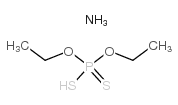
AMMONIUM O,O-DIETHYLDITHIOPHOSPHATE structure
|
Common Name | AMMONIUM O,O-DIETHYLDITHIOPHOSPHATE | ||
|---|---|---|---|---|
| CAS Number | 1068-22-0 | Molecular Weight | 203.26300 | |
| Density | 1.214g/cm3 | Boiling Point | 232.7ºC at 760mmHg | |
| Molecular Formula | C4H14NO2PS2 | Melting Point | 164-166 °C(lit.) | |
| MSDS | Chinese USA | Flash Point | 94.5ºC | |
| Symbol |

GHS07 |
Signal Word | Warning | |
| Name | kejunlin |
|---|---|
| Synonym | More Synonyms |
| Density | 1.214g/cm3 |
|---|---|
| Boiling Point | 232.7ºC at 760mmHg |
| Melting Point | 164-166 °C(lit.) |
| Molecular Formula | C4H14NO2PS2 |
| Molecular Weight | 203.26300 |
| Flash Point | 94.5ºC |
| Exact Mass | 203.02000 |
| PSA | 102.40000 |
| LogP | 3.18820 |
| Appearance of Characters | Crystalline |
| Vapour Pressure | 0.0153mmHg at 25°C |
| Index of Refraction | 1.546 |
| Storage condition | ?20°C |
Synonym:Ammonium O,O-Diethyl Diethiophosphate; Phosphorodithioic Acid, O,O-Diethyl Ester, Ammonium Salt Section 2 - COMPOSITION, INFORMATION ON INGREDIENTS
Risk Phrases: None Listed. Section 3 - HAZARDS IDENTIFICATION EMERGENCY OVERVIEW
Not available. Potential Health Effects Eye: May cause eye irritation. Skin: May cause skin irritation. Ingestion: May cause irritation of the digestive tract. Low hazard for usual industrial handling. Inhalation: May cause respiratory tract irritation. Low hazard for usual industrial handling. Chronic: No information found. Section 4 - FIRST AID MEASURES Eyes: Flush eyes with plenty of water for at least 15 minutes, occasionally lifting the upper and lower eyelids. If irritation develops, get medical aid. Skin: Flush skin with plenty of water for at least 15 minutes while removing contaminated clothing and shoes. Get medical aid if irritation develops or persists. Wash clothing before reuse. Ingestion: Never give anything by mouth to an unconscious person. Do NOT induce vomiting. If conscious and alert, rinse mouth and drink 2-4 cupfuls of milk or water. Wash mouth out with water. Get medical aid if irritation or symptoms occur. Inhalation: Remove from exposure and move to fresh air immediately. If not breathing, give artificial respiration. If breathing is difficult, give oxygen. Get medical aid if cough or other symptoms appear. Notes to Physician: Section 5 - FIRE FIGHTING MEASURES General Information: As in any fire, wear a self-contained breathing apparatus in pressure-demand, MSHA/NIOSH (approved or equivalent), and full protective gear. During a fire, irritating and highly toxic gases may be generated by thermal decomposition or combustion. Extinguishing Media: Use agent most appropriate to extinguish fire. Use water spray, dry chemical, carbon dioxide, or appropriate foam. Section 6 - ACCIDENTAL RELEASE MEASURES General Information: Use proper personal protective equipment as indicated in Section 8. Spills/Leaks: Vacuum or sweep up material and place into a suitable disposal container. Clean up spills immediately, observing precautions in the Protective Equipment section. Avoid generating dusty conditions. Provide ventilation. Section 7 - HANDLING and STORAGE Handling: Wash thoroughly after handling. Wash hands before eating. Remove contaminated clothing and wash before reuse. Use with adequate ventilation. Minimize dust generation and accumulation. Avoid contact with eyes, skin, and clothing. Keep container tightly closed. Avoid ingestion and inhalation. Storage: Store in a tightly closed container. Store in a cool, dry, well-ventilated area away from incompatible substances. No special precautions indicated. Section 8 - EXPOSURE CONTROLS, PERSONAL PROTECTION Engineering Controls: Facilities storing or utilizing this material should be equipped with an eyewash facility and a safety shower. Use adequate ventilation to keep airborne concentrations low. Exposure Limits CAS# 1068-22-0: Personal Protective Equipment Eyes: Wear appropriate protective eyeglasses or chemical safety goggles as described by OSHA's eye and face protection regulations in 29 CFR 1910.133 or European Standard EN166. Skin: Wear appropriate protective gloves to prevent skin exposure. Clothing: Wear appropriate protective clothing to prevent skin exposure. Respirators: Follow the OSHA respirator regulations found in 29 CFR 1910.134 or European Standard EN 149. Use a NIOSH/MSHA or European Standard EN 149 approved respirator if exposure limits are exceeded or if irritation or other symptoms are experienced. Section 9 - PHYSICAL AND CHEMICAL PROPERTIES Physical State: Crystals Color: white Odor: ammonia-like - unpleasant odor pH: Not available. Vapor Pressure: Not available. Viscosity: Not available. Boiling Point: Not available. Freezing/Melting Point: 164.00 - 166.00 deg C Autoignition Temperature: Not applicable. Flash Point: Not applicable. Explosion Limits, lower: Not available. Explosion Limits, upper: Not available. Decomposition Temperature: Solubility in water: Specific Gravity/Density: Molecular Formula: C4H14NO2PS2 Molecular Weight: 203.25 Section 10 - STABILITY AND REACTIVITY Chemical Stability: Stable under normal temperatures and pressures. Conditions to Avoid: Incompatible materials, dust generation, excess heat, strong oxidants. Incompatibilities with Other Materials: Strong oxidizing agents. Hazardous Decomposition Products: Carbon monoxide, irritating and toxic fumes and gases, carbon dioxide, sulfur oxides (SOx), including sulfur oxide and sulfur dioxide, phosphorous fumes, ammonia. Hazardous Polymerization: Has not been reported Section 11 - TOXICOLOGICAL INFORMATION RTECS#: CAS# 1068-22-0: BP8145000 LD50/LC50: CAS# 1068-22-0: Draize test, rabbit, skin: 500 mg Mild; Oral, rat: LD50 = 7900 mg/kg. Carcinogenicity: Diethyl Dithiophosphate, Ammonium Salt - Not listed by ACGIH, IARC, or NTP. Other: See actual entry in RTECS for complete information. Section 12 - ECOLOGICAL INFORMATION Section 13 - DISPOSAL CONSIDERATIONS Dispose of in a manner consistent with federal, state, and local regulations. Section 14 - TRANSPORT INFORMATION IATA Not regulated as a hazardous material. IMO Not regulated as a hazardous material. RID/ADR Not regulated as a hazardous material. Section 15 - REGULATORY INFORMATION European/International Regulations European Labeling in Accordance with EC Directives Hazard Symbols: Not available. Risk Phrases: Safety Phrases: S 24/25 Avoid contact with skin and eyes. S 28A After contact with skin, wash immediately with plenty of water. S 37 Wear suitable gloves. S 45 In case of accident or if you feel unwell, seek medical advice immediately (show the label where possible). WGK (Water Danger/Protection) CAS# 1068-22-0: No information available. Canada None of the chemicals in this product are listed on the DSL/NDSL list. CAS# 1068-22-0 is not listed on Canada's Ingredient Disclosure List. US FEDERAL TSCA CAS# 1068-22-0 is not listed on the TSCA inventory. It is for research and development use only. SECTION 16 - ADDITIONAL INFORMATION N/A |
CHEMICAL IDENTIFICATION
HEALTH HAZARD DATAACUTE TOXICITY DATA
MUTATION DATA
|
|
~% 
AMMONIUM O,O-DI... CAS#:1068-22-0 |
| Literature: WO2005/95425 A1, ; Page/Page column 26-27 ; |
|
~97% 
AMMONIUM O,O-DI... CAS#:1068-22-0 |
| Literature: Kaboudin, Babak; Norouzi, Hamid Synthesis, 2004 , # 12 p. 2035 - 2039 |
|
~% 
AMMONIUM O,O-DI... CAS#:1068-22-0 |
| Literature: J. Gen. Chem. USSR (Engl. Transl.), , vol. 51, # 4 p. 738 - 745,602 - 608 |
| HS Code | 2931900090 |
|---|---|
| Summary | 2931900090. other organo-inorganic compounds. VAT:17.0%. Tax rebate rate:13.0%. Supervision conditions:AB(certificate of inspection for goods inward,certificate of inspection for goods outward). MFN tariff:6.5%. General tariff:30.0% |
|
Simple hollow fiber renewal liquid membrane extraction method for pre-concentration of Cd(II) in environmental samples and detection by flame atomic absorption spectrometry.
Anal. Chim. Acta 638(1) , 45-50, (2009) A hollow fiber renewal liquid membrane (HFRLM) extraction method to determine cadmium (II) in water samples using Flame Atomic Absorption Spectrometry (FAAS) was developed. Ammonium O,O-diethyl dithio... |
|
|
Effects of some chelating agents on the uptake and distribution of 203Hg2+ in the brown trout (Salmo trutta): studies on ethyl- and isopropylxanthate, diethyl- and diisopropyldithiophosphate, dimethyl- and diethyldithiocarbamate and pyridinethione.
Arch. Toxicol. 62(5) , 387-91, (1988) Brown trout, Salmo trutta, were exposed to water containing 0.1 microgram/l 203Hg2+, alone or with potassium ethylxanthate (PEX), sodium isopropylxanthate (SIX), sodium diethyldithiophosphate (SEP), s... |
|
|
Thermospray flame furnace-AAS determination of copper after on-line sorbent preconcentration using a system optimized by experimental designs.
Anal. Sci. 21(11) , 1337-42, (2005) The present paper describes the on-line coupling of a flow-injection system to a new technique, thermospray flame furnace-AAS (TS-FF-AAS), for the preconcentration and determination of copper in water... |
| ammonium O,O-diethyl phosphorodithioate |
| MFCD00012635 |
| EINECS 213-942-4 |
| AMMONIUM O,O-DIETHYLDITHIOPHOSPHATE |
| Ammonium O,O-Diethyldithiophosphate, Typically |
| O,O-Diethyl hydrogen dithiophosphate ammonium salt |
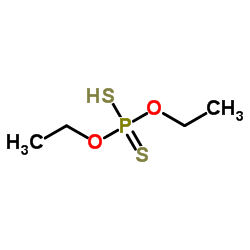

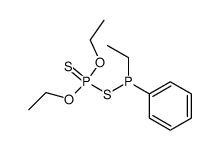
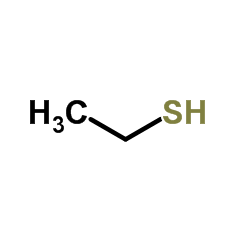
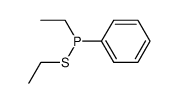
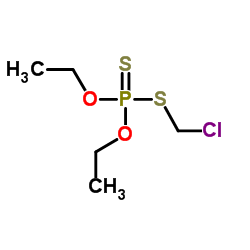 CAS#:24934-91-6
CAS#:24934-91-6 CAS#:563-12-2
CAS#:563-12-2 CAS#:13286-49-2
CAS#:13286-49-2![diethoxy-[(3-methyl-1,2,4-oxadiazol-5-yl)methylsulfanyl]-sulfanylidene-λ5-phosphane structure](https://image.chemsrc.com/caspic/134/14374-19-7.png) CAS#:14374-19-7
CAS#:14374-19-7